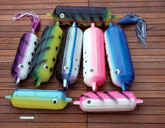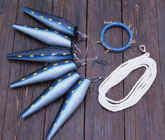When big game is the call, the look of the trolling spread trumps the size of the boat every time.
 |
| The author tweaks this basic eight-line spread to reflect the conditions, but he generally runs an Ilander-ballyhoo combo off the long flat line. Photo: Pete Sucheski |
Trolling for big game from a small boat seems to present an angling challenge: Is it possible to create an effective trolling spread in a small boat? Compared to a large sport-fishing boat that can place an impressive number of baits over a large swath of water, a small boat would seem to offer a reduced window in which to build an illusion with a trolling spread. The tighter cockpit limits the number of rods that can be reasonably deployed, while the narrow beam of the boat and its shorter outriggers diminish the width of the entire spread.
While one may think these limitations would put small-boat trollers at a disadvantage, quite the contrary is true. A small boat can be as effective on the troll as the big boys, provided the crew aboard has a solid understanding of how to build enticing spreads and choose the proper trolling speed. The tuna, wahoo, dolphin and even marlin caught by big sportfishermen are easily within reach for a well-equipped small boat.
Small Spread, Big Results
The fundamental point of trolling is to arrange baits to create the illusion of a school of panicked bait. While the typical small-boat, four-bait spread will catch its share of fish, so few baits can be a handicap when the fish are widely scattered or competition from other boats is stiff. In both cases, more baits in the spread will create more commotion and better results.
While the best way to arrange baits in a spread is open to debate, I generally base my trolling spread around a modified diamond pattern. I stagger the baits and make each individual one stand out, as opposed to running the baits side-by-side and in tight formation. I do this because I believe that when a fish enters a spread, it has isolated one bait and is focused on it. If that one bait is skipping along pretty much by itself '’’ and there's nothing else to distract or deter the predator from moving in on it '’’ a strike is virtually assured. Staggered baits also help to reduce the risk of a hooked fish becoming tangled in another line.
The staggered formation also mimics the natural actions of a school of fleeing baitfish, where weaker and slower members often get separated from the main group, and become easier prey.
To create this modified diamond pattern, I place my close flat-line bait '’’ which represents the lead bait in the pack '’’ right where the prop wash fades to clean water. From there, I stagger the respective baits back in the spread at distances ranging from as little as 15 feet '’’ such as when we're marking multiple gamefish in an area and the bite is on '’’ to as much as 50 feet or more, depending on the species we're targeting and how they seem to be reacting to our patterns. It's a game of constant adjustment, broadening or shortening the diamond pattern as conditions change and develop.
Behind my close flat line is usually where I position my close center 'rigger bait '’’ I fish two baits from the center 'rigger '’’ followed by the long flat-line bait. I'll position the close, port outrigger bait farther back than the long flat-line bait, with my close starboard outrigger bait positioned back from the close outrigger bait. The long port outrigger bait is next '’’ beyond the short starboard outrigger bait. Then comes the long starboard outrigger bait, placed farther back than the long port outrigger bait. My long center 'rigger bait is fished at least 300 feet behind the spread.
This arrangement enables me to fish eight baits aboard my 28-foot center console, and dramatically enhances the mass and appeal of my spread '’’ just like a big boat '’’ and the effort usually pays off in raising more fish.
How the outriggers and center 'rigger are rigged is the key to serious blue-water trolling. Rather than rig each outrigger pole with one line and release clip, I run two independent lines and clips from each pole. The primary line runs all the way to the top, through all three eyes on an outrigger pole, while the secondary line runs only up through the first two eyes. Each outrigger line has an adjustable swivel which enables me to loosen or tighten its tension to help tune the actions of the baits.
By rigging independent lines and clips, as opposed to running two release clips off one main line, I get baits that track much better. Running two release clips off the same line can strongly influence the actions of their baits. Large baits, such as a mackerel, mullet or a big trolling lure, generate more resistance and pull more strongly on the outrigger line, exceeding the drag and pull generated by a smaller bait. When this happens, the clip with the lighter bait "flips" or "dances" wildly and causes its bait to swim or skip erratically. This is not the desired effect and the fishing line could possibly get wrapped up in the swinging clip.
Such a Tease
Building an effective small-boat trolling spread doesn't end at the outriggers and bait performance. Creating a complete subsurface illusion will make the spread more effective.
I've played with three teaser designs, with good success. One is the MoldCraft Boat Fender teaser.
 |
| Boat Fender teasers resemble predators in the spread. Photo: George Poveromo |
As its name implies, this is a plastic boat fender painted to resemble a fish. Rigged on heavy mono and with a weight under its lip, the fender swims erratically a few feet beneath the surface. It creates the illusion of a larger predator in the spread and sometimes provokes a gamefish into striking, which I think is a reaction to the presence of competition.
The Pin Teaser is another subsurface system designed to mimic a chain of small bonito and dolphin. Resembling a bowling pin in shape and size, and painted like bonito or dolphin, the teasers are available in a six- or four-pin chain configuration. There's now a system of 71/2-inch-long pin teasers called the Little Lulu Teaser.
One other system I've been pulling quite a bit lately is the Strip Teaser, basically a six-arm dredge that tows clear plastic strips adorned with reflective fish images. Depending upon the weight of the dredge, amount of line played out and trolling speed, this system performs about five or six feet beneath the surface and yields a life-like illusion of a school of bait. I tie the Strip Teaser off to a transom cleat after positioning it where we can just barely see it working. I'll reposition the close flat-line bait so that it rides at the surface a few feet behind the teaser, to give the illusion of a weak bait lagging behind. I'll sometimes reposition the short outrigger bait off to the side of the teaser, to further build the bait-ball illusion.
Many teaser systems on the market are compatible with small boats and go a long way in creating extra commotion and drawing attention to a trolling spread.
From the Top Down
It's also advantageous to fish a bait or two beneath the surface. At the very least, I'll troll a ballyhoo-tipped Ilander off my long flat line, where it rides several inches beneath the surface. When bites on top are scarce, and especially during the heat of summer, I'll use a Sea Striker HS8 high-speed planer to take that combo several feet deeper. On many occasions that subsurface bait has made a big difference.
A downrigger is another way to place a bait in a specific part of the water column. A bait can be fished deep by itself, or positioned behind and beneath one of the teasers.
Speed Needs
 |
| Photo: George Poverom |
There is no magical trolling speed that drives fish into striking. The idea is to build up just enough speed to get the baits working the way they're supposed to. That is, skipping baits should just be breaking the surface, while swimming baits should be swimming along right beneath the surface. Lures should look enticing. The positioning of the baits or lures may require a little fine-tuning, but once it all looks ideal behind the boat, I know I've hit the right speed.
Speed adjustments are usually required to change direction '’’ I may need more speed to keep the baits working when heading directly into a sea, less when heading down-sea. If I know fish are in the area and strikes still seem slow, I experiment a bit, trying a few faster passes, then a few slower. Sometimes a faster speed triggers a positive response and vice versa. Also, when picking up the pace, you may have to drop the baits farther back to keep them from leaping out of the water.
Double Up
On the strike, don't immediately slow the boat or shift into neutral '’’ continue on at the same speed for at least 30 seconds. This will help take the stretch out of the monofilament line and provide a better hookset, and will keep the other baits swimming right along, still tempting to fish that may be around but haven't hit yet. This is how you get those double- and triple-headers.
Trolling up big fish aboard a small boat is certainly feasible, and understanding how to create and troll a unique and attention-getting bait spread in a limited amount of space is the key. Just stick to the basics and throw in a few extra tricks, and you'll be into quality fish season after season.

